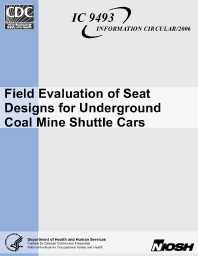Mining Publication: Field Evaluation of Seat Designs for Underground Coal Mine Shuttle Cars
Original creation date: November 2006
Researchers with the National Institute for Occupational Safety and Health (NIOSH) conducted a systematic study to evaluate seat designs on low- and mid-coal-seam shuttle cars. The purpose was to gather additional data to support earlier findings that NIOSH seats, with unique viscoelastic foam padding, are indeed improved designs for coal mine shuttle cars. This study included a larger sample of shuttle car operators than a prior NIOSH investigation. Eight shuttle car operators participated in evaluating seat designs on the basis of perceived levels of vehicle jarring/jolting and discomfort. Researchers then compared the operators' perceptions with field-measured levels of vehicle jarring/jolting. Seven seat designs were evaluated on low- and mid-coal-seam shuttle cars during production operations at two underground coal mines in southern West Virginia. These seat designs comprised the one already in use on each vehicle and five NIOSH designs. Experimental data were collected using accelerometers, signal conditioning amplifiers, and filters connected to a data recorder, whereas subjective data were gathered via a visual analog scale (VAS) and a questionnaire. Field trials included shuttle cars operating under full and no-load conditions. VAS responses indicated that NIOSH-designed seats performed better relative to comfort and isolation from vehicle jarring/jolting than the existing seats used in the shuttle cars. Both mid- and low-coal-seam shuttle car operators, during no-load and full-load conditions, rated lower levels of jarring/jolting with the NIOSH seat design. Questionnaire responses indicated that shuttle car operators rated NIOSH seat designs as more comfortable. Vehicle operators most frequently suggested the addition of armrests as a way to improve the seats on the mid-seam shuttle car. The quantitative levels of vehicle jarring/jolting for the no-load condition (more severe condition for vehicle operation) showed that NIOSH seats for the mid-coal-seam shuttle car performed better than the existing seat in terms of peak acceleration and crest factor. Similarly, for the low-coal-seam shuttle car, NIOSH seats performed better than the existing seat in terms of peak acceleration, root-mean-square (RMS) acceleration, and crest factor. This research will provide the mining industry with better seat designs for isolating operators from vehicle jarring/jolting. Furthermore, equipment manufacturers are afforded the opportunity to refine and improve the NIOSH seat designs using information gathered from this research study.
Authors: AG Mayton, CC Jobes, NK Kittusamy, DH Ambrose
Information Circular - November 2006
NIOSHTIC2 Number: 20031327
Pittsburgh, PA: U.S. Department of Health and Human Services, Public Health Service, Centers for Disease Control and Prevention, National Institute for Occupational Safety and Health, DHHS (NIOSH) Publication No. 2007-100, IC 9493, 2006 Nov; :1-40
See Also
- The Consequences of 'Leaky' Enclosures
- Hearing Loss Prevention in Mining - 2005
- Laboratory Investigation of Seat Suspension Design Performance during Vibration Testing
- Partial Cab Video and Information Suite
- Practical Application of a Partial Cab to Reduce the A-Weighted Sound Level at the Operator's Station on Surface Drill Rigs
- Systematic Comparison of Different Seats on Shuttle Cars Used in Underground Coal Mines
- Task Analysis
- Technology News 527 - The Partial Cab: A New Noise Engineering Control for Surface Drill Rigs
- Technology News 536 - NIOSH Develops New Software to Analyze and Reduce Noise Exposure
- Transverse-Mounted End-Cab Design for Low-Coal Shuttle Cars
- Content source: National Institute for Occupational Safety and Health, Mining Program


 ShareCompartir
ShareCompartir
